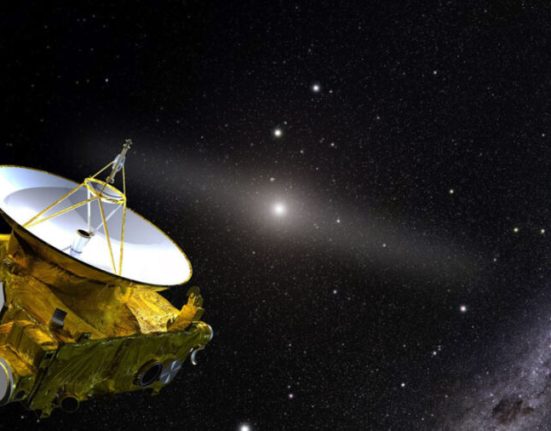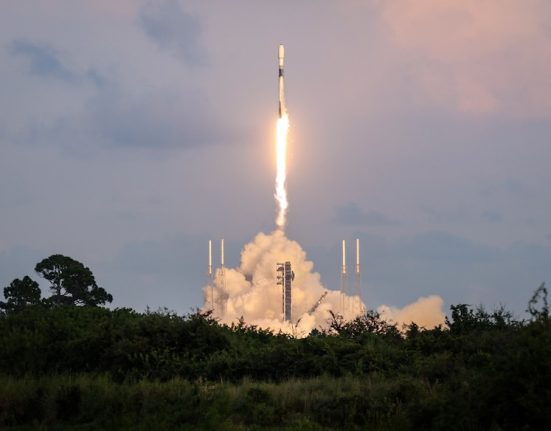
Update 6:06 a.m. EDT: The Dragon Resilience crew has separated from the Falcon 9 upper stage.
Despite challenging weather at the start of the launch window, SpaceX managed to send the Polaris Dawn Commercial astronaut mission to low Earth orbit on the second of three available launch opportunities.
The pre-dawn launch kicked off the journey of four astronauts aboard the SpaceX Crew Dragon spacecraft, named Resilience. The flight's accompanying Falcon 9 rocket lifted off Tuesday at 5:23 a.m. EDT (0923 UTC).
“You are embarking on a journey, not just for yourselves, but for all of humanity. Each of you has trained tirelessly and prepared rigorously for this moment, the moment when we will soar higher in space than ever before,” said Frank Messina, Polaris Dawn launch director. “As you look toward the North Star, remember that your courage lights the way for future explorers.
“We trust in your skills, your courage, and your teamwork to carry out the mission that awaits you. Please know that the team back here is with you every step of the way, watching, supporting, and cheering you on as you journey into space. We send you hugs from Earth. May God be with you, Polaris Dawn crew. May you make history and return home safe and sound.”
“Dragon, CE (chief engineer), welcome to orbit. The Dragon team is honored to help you begin your incredible journey,” added Jared Metter, the chief engineer for the Polaris Dawn mission. “We hope you enjoyed the ride. The entire SpaceX family looks up to you. Godspeed and good luck.”
“We appreciate your kind words. We wouldn’t be on this journey without the 14,000 people at SpaceX and everyone else cheering us on,” said mission commander Jared Isaacman. “We appreciate it and we’ll get to work now.”
Polaris Dawn, the first of three planned missions for the Polaris Program, will include the first commercial spacewalk, an in-orbit demonstration of Starlink, and will send its crew farther from Earth than humans have gone since the end of the Apollo era.
Its crew includes Isaacman, CEO of Shift4 Payments and commander of the Inspiration4 mission; former U.S. Air Force pilot Scott “Kidd” Poteet; and SpaceX employees Sarah Gillis and Anna Menon. Gillis and Menon became the first current SpaceX employees to travel to space.
The mission is a free flight for Resilience, which will last a little over five days in total. SpaceX therefore also needed good weather conditions for recovery before splashdown on the coast of Florida.
After an initial issue with ground systems during the first launch attempt, weather conditions during splashdown have been the sticking point that has kept this mission grounded so far. In its post on X, formerly Twitter, announcing the new planned launch date, SpaceX said that “conditions at potential splashdown sites for Dragon's return to Earth remain an issue.”
“This is a huge improvement over the last two weeks,” Isaacman said in a post on X before the launch. “We are getting closer to getting this mission into orbit.”
At the time of release, the National Hurricane Center was tracking Tropical Storm Francine in the Gulf of Mexico along with two other storm systems moving over the waters of the Atlantic Ocean.
“An elongated area of low pressure over the central tropical Atlantic is producing disorganized shower and thunderstorm activity,” the NHC wrote. “Environmental conditions appear to be only marginally conducive for slight development over the next few days, but a tropical depression could still form during that time as the system moves westward at 5 to 10 mph over the central tropical Atlantic.”

The Falcon 9 rocket supporting the mission, with tail number B1083 in SpaceX's fleet, launched for the fourth time on this flight. It previously supported the Crew-8 mission to the International Space Station and sent two batches of SpaceX's Starlink internet satellites into low-Earth orbit.
With the Crew Dragon spacecraft atop, the launch vehicle reaches a height of 65 m (213.3 ft). Dubbed Resilience, Dragon made its third trip to space after launching both the Crew-1 mission and Inspiration4, Isaacman's first trip beyond Earth.
Because Resilience will launch into a 190 x 1,200 km (118 x 746 mi) orbit at a 51.6-degree inclination, B1083 will land on SpaceX's unmanned Just Read the Instructions spacecraft about 9.5 minutes after liftoff.
Time was running out for this mission to get off the ground. NASA needed SpaceX to begin preparing the pad at Launch Complex 39A for the launch of a Falcon Heavy. That rocket is needed to launch NASA’s Europa Clipper mission on its way to the Galilean moon of Europa.
The planetary launch window opens on October 10 and it will take weeks to convert the platform from a Falcon 9 configuration to a Falcon Heavy.
“SpaceX continues to improve and reduce LC-39A platform conversion processing times when changing configurations between Falcon 9 and Falcon Heavy,” said Tim Dunn, senior launch manager for NASA’s Launch Services Program. “LSP will utilize these improvements for the Europa Clipper mission. The exact number of days required for the configuration change has not yet been determined, but will be less than 25 days.”














Leave feedback about this